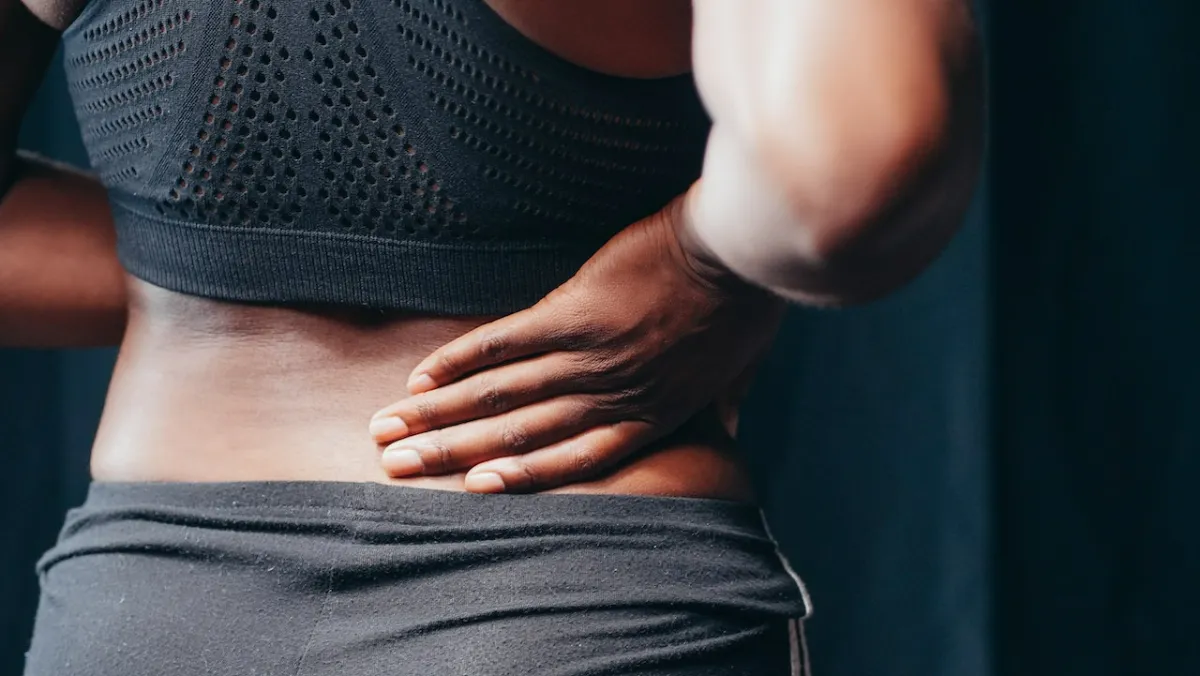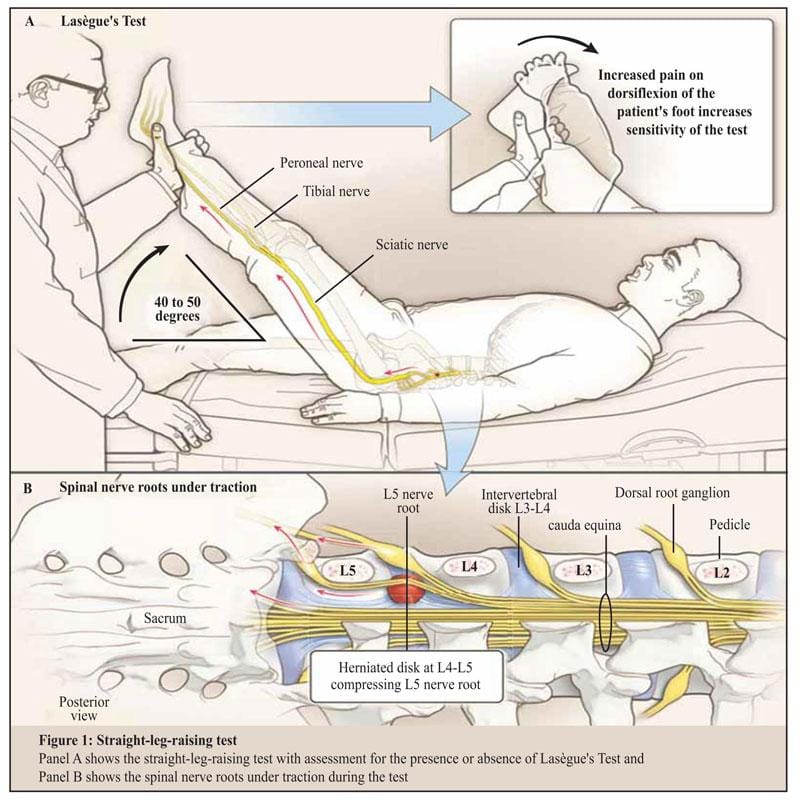Sciatica is a common condition that affects many people worldwide. It is characterized by pain, numbness, and weakness in the lower back, buttocks, and legs. This article will explore the definition, pathophysiology, etiology, risk factors, diagnosis, and treatment options for sciatica. We will also discuss the prognosis of this condition and provide a summary of the key points. Whether you are a healthcare professional or experiencing sciatica, this article will provide valuable information to help you better understand this condition.
What is Sciatica by definition?
Sciatica is a commonly used term to indicate pain radiating from the lower back into different locations in the legs and feet; these may also include pain generated from the inguinal to femoral regions.
Introduction of Sciatica
Sciatica is also commonly referred to as radiating leg pain and back pain, and a disability commonly converted into a pain scale from (no pain) 0 to 100 (Worst pain). Sciatica can be caused due to nerve impingement at the lumbosacral nerves and muscular entrapment to the piriformis muscle. In about 90% of cases, sciatica is caused by a herniated disc with nerve root compression. Lumbar disc herniation, defined as protrusions of disc material that go outside the confines of the annular lining, is a common condition that affects the spine in young and middle-aged adults and is one of the leading causes of lower back pain and sciatica.

The first approach to treatment in sciatic patients is the use of conservative treatments, which commonly includes the use of dermal analgesics (pain numbing), reduction in activity, rest, physical therapy, chiropractic care, pharmacotherapy, medications, and alternative medicines, along With saline injections, or steroidal epidural injections at its most severe. If the conservative approach is of no relief, more invasive procedures such as total disc replacement or percutaneous laser disc decompression (PLDD) can be called for. The most commonly used invasive treatment is epidural injections, which is thus far the most effective short-term treatment for sciatica. However, this review has discussed Sciatica’s causes, clinical features, and management.
Pathophysiology of Sciatica
The intervertebral disc was implicated in the pathophysiology of Sciatica, and with the assumption that the protruding disc exerted pressure on Sciatic nerve roots, the treatment was surgical removal of the disc. Any subsequent improvement in symptoms was attributed to the relief of pressure on the nerve roots. Disc pathology and stenosis With apparent neural compromise are relatively common findings in asymptomatic patients.
Symptomatic patients with disc herniation may experience marked improvement in symptoms without altering the original pathology, whereas removing herniated disc material or other causes of nerve root compression does not permanently relieve pain. A positive correlation was noted between contact pressure and preoperative neurological impairment, Suggesting that pressure leads to loss of instead whereas function than pain; chymopapain, a Substance used for chemonucleolysis of herniated lumbar discs, may cause a rapid relief of leg pain that precedes any change in the size of the disc herniation or degree of nerve root impingement.
These observations suggest that processes other than the pressure on nerve roots are involved in developing sciatic neuralgia. The evidence suggests a complex interplay of immunological and pressure-related processes may be involved.
Immunological:
Some evidence suggests that the immune system also may play a part in the reaction between the nerve root and the exposed nucleus pulposus. Glycosphingolipids (GSLS) are particularly abundant in central and peripheral nervous cell types. Antibodies to GSLS were measured in patients with acute and chronic sciatica and those who had lumbar discectomy for disc herniation. Raised antibody levels to GSLS Were an overview of the pathogenesis of discogenic sciatica. Finally, an immune reaction to the nervous tissue may be involved in the pathogenesis of both acute and chronic sciatica.
Mechanical compression:
There is also some evidence to suggest that nerve root compression may also be involved. Administration of a nitroprusside infusion, a source of NO, leads to increasing ectopic firing only in those With cauda equina compression. An observational study with magnetic resonance imaging (MRI) in consecutive patients with leg pain noted that 9.6% had no disc disease, 3.3%, 11.4%, 68.5% extrusion, and 7.1% disc sequestration, bulging, and protrusion, respectively. Histological examination of nerve roots revealed edemas in both nucleus pulposus in exposed and displaced nerve roots, slightly more severe in the displaced group. The above evidence suggests that radicular pain in sciatic nerve roots arises from a complex interaction of immune and pressure-related elements.
Etiology of Sciatica

Lumbar bulging or a herniated disc:
A bulging disc is also known as a contained disc disorder. This means the gel-like center (nucleus pulpous) remains enclosed Within the disc’s tire-like outer wall (annulus fibrosus). Sciatic pain can be caused by herniated discs in the lumbar and sacral region and can range in level depending on the severity of the herniation. A herniated disc occurs when the nucleus breaks through the annulus. It is called a non-contained disc disorder.
Whether a disc bulges or herniates, disc material can press against an adjacent nerve root, compress delicate nerve tissue, and cause sciatica. The consequences of a herniated disc are worse. Not only does the herniated nucleus cause direct compression of the nerve root against the interior of the bony spinal canal, but the disc material also contains an acidic chemical irritant (hyaluronic acid) that causes nerve inflammation.
The severity of the pain and herniation will dictate the best treatment methods for the patient. Yet, disc herniation in sciatica does not always lead the patient to suffer sciatic pain; however, most often, a disc herniation causes some level of pain. In both cases, nerve compression and irritation cause inflammation and pain, often leading to extremity numbness, tingling, and muscle weakness.
Lumbar spinal stenosis spinal:
Stenosis is a nerve compression disorder most often affecting mature people. Leg pain similar to sciatica may occur due to lumbar spinal stenosis. The pain is usually positional, often brought on by activities such as standing or walking, and relieved by sitting down. Spinal nerve roots branch outward from the spinal cord through passageways called neural foramina, comprised of bone and ligaments. A foramen is between each set of Vertebral bodies on the left and right sides.
Nerve roots pass through these openings and extend beyond the spinal column to innervate other body parts. Foraminal stenosis is used when these passageways become narrow or clogged, causing nerve compression.
Piriformis syndrome and back pocket sciatica:
The piriformis syndrome has been attributed to compression of the sciatic nerve underlying the piriformis muscle, which stabilizes and serves as an external hip rotator. Although the nature and frequency of the Syndrome are uncertain, the most consistent features, derived from a systematic review, are focal mid-buttock pain, tenderness over the Sciatic notch, aggravation of pain after sitting, and provocation with maneuvers that increase piriformis muscle tension, such as external rotation of the hip.
Pain with the straight-leg-raising maneuver was reported in a meta-analysis to occur in approximately half of the cases. It is presumed that an injured piriformis muscle, sometimes caused by running, stretching, or lunging, compresses the sciatic nerve, but the pathophysiology is unclear. Electro-diagnostic and imaging tests are usually normal. Wallets, cell phones in back pockets, prolonged sitting on hard surfaces, and car seats can also produce Sciatica.
Spondylolisthesis:
Spondylolisthesis is a disorder that most often affects the lumbar spine. It is characterized by one vertebra slipping forward over an adjacent Vertebra. When a vertebra slips and is displaced, spinal nerve root compression occurs and often causes sciatic leg pain. It is categorized as developmental (found at birth, develops during childhood) or acquired from spinal degeneration, trauma or physical stress i.e. weightlifting.
Zoster sine herpete:
For the first few days before the eruption of shingles in a lumbar or upper sacral dermatome, herpes Zoster reactivation closely simulates sciatica caused by disk rupture. Diagnosis is difficult in the intervening days, especially in the few instances when the rash never develops.
Traumatic injury to the sciatic nerve:
Traumatic injury of the Sciatic nerve occurs with pelvis fractures or after a proximal hamstring injury and extreme nerve stretching. Muscle hematomas or tendinous injuries may cause severe sciatica. Posterior hip dislocation or femoral fracture impinges on the nerve; sciatica may also occur during the relocation of the hip joint. Injection site damage in the buttocks is a self-evident but infrequent Cause.
Spinal tumors:
Spinal tumors are abnormal growths, either benign or cancerous (malignant). Fortunately, spinal tumors are rare. However, when a spinal tumor develops in the lumbar region, there is a risk for sciatica to develop due to nerve compression.
Obesity:
Most people know that obesity contributes to the development of coronary heart disease, diabetes, high blood pressure, and colon cancer. Obesity is a causative factor in back pain. Being overweight or obese can significantly contribute to symptoms associated with osteoporosis, osteoarthritis, rheumatoid arthritis, and degenerative disc disease.
Gynecologic:
Deposits of endometrial tissue on the proximal nerve can cause recurrent cyclic or catamenial Sciatica, more often on the right than on the left. Large ovarian cysts and uterine enlargement associated with late pregnancy can compress the nerve between the fetal head and the pelvic brim. It is not unusual for a woman to have unilateral or bilateral sciatica post-partum, regardless of whether forceps were used during delivery; sciatica ostensibly occurs after a Woman has spent a prolonged time in the lithotomy position.
Some risk factors contribute to sciatica. The following risk factors are given in Table 1.
Table 1: Risk factors for sciatica
Personal factors
- Age
- Height
- Smoking
- Mental stress
Occupational factors
- Strenuous physical activity
- Driving
- Clinical features
The most important symptom of sciatica is lumbosacral radicular leg pain that follows a dermatomal pattern radiating below the knee and into the foot and toes. The pain Worsens with coughing; patients may report sensory symptoms, limited forward flexion of the lumbar spine, gait deformity and unilateral spasm of the Paraspinal muscles. Sciatic pain can vary widely, but some common symptoms are given below:
> Sharp pain in one part of the leg or hip and numbness in other parts.
> The affected leg may feel weak and thin than the unaffected leg.
> There will be a mild tingling, dull ache, or burning sensation; the sensations may also be felt on the back of the calf or the sole.
> Redness and Swelling of the back or spine.
> Sciatica usually occurs in only one leg at a time. The sensation is like an electric shock. Sciatica pain is often felt while sneezing, coughing, going to the toilet, or even sitting and may be accompanied by lower back pain.
Diagnosis of Sciatica
Sciatica is mainly evaluated by history taking, physical examination, and clinical tests. Many clinical tests have been devised to determine whether sciatic pain is caused by spinal nerve root disk compression; most tests are variations of the straight-leg-raising test, also known as Lasegue’s test (Figure 1).
In a patient in the supine position, raising the leg with the knee extended stretches the nerve root over the protruded disk and results in a response of muscle contraction. A positive test consists of reproducing or marked Worsening of the patient’s initial pain and firm resistance to further leg elevation. A diagnosis of disk compression is likely if the pain radiates from the buttock to below the knee when the angle of the leg is between 30 and 70 degrees.
Many persons without spinal abnormalities have hamstring and gluteal tightness, With discomfort elicited by straight leg raising. Still, the pain is more diffuse than in sciatica, and the leg can be lifted higher if the maneuver is performed slowly. Increased pain on dorsiflexion of the foot or large toe increases sensitivity. The crossed straight-leg-raising test (Fajersztajn’s test) involves raising the unaffected leg; in a positive test, sciatic pain is elicited in the opposite (affected) leg. This test is 90% specific for disk herniation on the contralateral side but is insensitive. Some indicators may help in the diagnosis of Sciatica, and the indicators are given in Table 2.
Imaging: Imaging may be indicated only if indications indicate that the Sciatica may be caused by underlying disease (infections, malignancies) rather than disc herniation. Diagnostic imaging may also be indicated in patients with severe symptoms who fail to respond to conservative care for 6 to 8 Weeks. In these cases, imaging is used to identify if a herniated disc with nerve root compression is present and its location and extent.
Table 2: Indicators of Sciatica
- Unilateral leg pain greater than low back pain
- Pain radiating to foot or toes
- Numbness and paraesthesia in the same distribution
- Straight leg raising test induces more leg pain
Magnetic resonance imaging:
The nature and location of disk rupture and spinal lesions, such as osteoarthritic disease and spondylolisthesis, lateral recess stenosis, and synovial cysts of the facet joint, can be accurately seen on magnetic resonance imaging (MRI) without the administration of gadolinium. A high rate of minor abnormalities is seen on MRI in patients without back or radicular symptoms, but disk rupture is seen in less than 1% of asymptomatic patients.
Computed tomography:
Computed tomography (CT) is performed less frequently but reveals most disk herniations and structural changes in the spine. CT and MRI each have a role in exploring the pelvic fossa when sciatic compression is suspected in those regions.
Electromyography:
Electromyography (EMG) aid in diagnosis by revealing a topographic distribution of muscular denervation corresponding to a nerve root. Denervation occurs longer in distal than in proximal muscles. The most specific findings are fibrillations and sharp Waves in muscles corresponding to a single nerve root, the latter results from the preganglionic site of root compression, leaving the cell body and distal axon unaffected.
Treatment of Sciatica
Conservative treatment
Self-care measures can help relieve sciatica symptoms and prevent a recurrence. The conservative treatments are given in Table 3.
Medications
Pain medications may vary considerably. Specific types and causes of pain may respond better to one kind of pain medication than another. These all may suppress the Sciatica pain temporarily, not permanently. Medications used to treat pain include:
Analgesics:
Analgesics such as acetaminophen and tramadol are used, they can relieve pain, but they don’t have the anti-inflammatory effects of NSAIDs.
Nonsteroidal anti-inflammatory drug (NSAID)
NSAIDs such as aspirin, ibuprofen, naproxen, and celecoxib are nonsteroidal anti-inflammatory drugs used to reduce inflammation and relieve pain. Long-term use of analgesics and NSAIDs may cause stomach ulcers and kidney and liver problems.
Table 3: Conservative treatment of sciatica
- Swelling can be reduced by using alternate cold and hot packs, and discomfort can be relieved.
- Good posture must be practiced. A good posture is received when a person stands up straight with the ears aligned with the shoulders, and the shoulders must be aligned with the hips with the knees slightly bent.
- Regular exercise should be done as it improves flexibility and helps prevent age-related degenerative changes in the back.
- One should be very careful while lifting objects. Objects should always be lifted from a squatting position, using the hips and legs to do the heavy Work, and the back should never be bent governor it should be straight.
- Sitting or standing for extended periods should be avoided. If anyone sits at work, take regular breaks to stand and walk around.
- One should sleep in a proper sleeping posture. The best method is to take the pressure off the back by sleeping on one side or the back with a pillow under the knees.
- Wearing high heels should be avoided. Best shoes with heels over 1% inches high shift the weight forward, throwing the body out of alignment.
- Abdominal crunches should be done regularly. These exercises strengthen the abdominal muscles that help to support the lower back.
- Laying with the face in the down position and clasping the hands behind the lower back, the head and chest should be raised slightly against gravity while looking at the floor.
- Sitting on a chair, the body should be stretched and slightly bent toward the floor. This exercise should be repeated 6 to 8 times. It should be stopped when there is slight discomfort.
- One should lie on his back and gently pull the knees to provide a comfortable stretch.
- Regularly walk and Swim as these exercises help strengthen the lower back.

Muscle relaxants:
Muscle relaxants such as baclofen can treat pain associated with muscle spasms and Spasticity.
Anticonvulsants:
Anticonvulsants such as phenytoin and carbamazepine, gabapentin can be used to relieve nerve pain as in trigeminal neuralgia.
Steroids:
Steroids can be used to reduce the swelling and inflammation of the nerves. They are taken orally in a tapering dose over five days. They have the advantage of providing pain relief Within a 24 hour period. Steroid injections may be prescribed in the area of the pain if the pain is severe.
Epidural steroid injections:
This procedure is usually performed under fluoroscopy, and it involves an injection of steroids with an analgesic numbing agent into the epidural space of the spine to reduce the swelling and inflammation of the nerves. About 50% of patients will notice relief after an epidural injection, although the results are temporary. This procedure is usually done in a series of three, at 2-week intervals, to obtain the best results in the shortest time. If the injections are helpful, the series can be done up to thrice a year.
Facet injections:
Facet injections are used for patients with low back pain stemming from inflammation or facet joint irritation. They may be performed using a fluoroscope (X-ray), which directs a needle through the skin and muscles to the path of the sensory nerves in the facet joints. At that point, numbing medicine and cortisone are injected into the facet joint.
Narcotics (opioids):
Narcotics are powerful pain relievers that deaden a person’s perception of pain. They are used for 2 to 4 weeks after an acute injury or surgery. Common narcotics include codeine, meperidine, propoxyphene, hydrocodone, oxycodone, Sumatriptan, and naratriptan, which relieve a migraine headaches.
Surgical treatment of sciatica
Sciatica resolves without treatment in one-third of patients within 2 weeks and in three-quarters of patients within 3 months after onset. Nevertheless, most trials comparing Surgical and conservative treatment of sciatica due to lumbar disk disease favor surgery because it results in earlier pain relief. Patients who had sciatica for 6 to 12 weeks and Were assigned to lumbar disk surgery had faster and more pronounced pain relief than those assigned to conservative treatment. Surgery has been recommended in cases of large disk ruptures into the spinal canal that compresses the cauda equina and causes the failure of the bladder or bowel sphincter.
Sciatica treatment using decompression of a lumbar nerve root is most likely to succeed if symptoms conform to the typical clinical pattern and imaging studies show disk rupture. Several open and percutaneous Surgical approaches have been devised. A unilateral hemilaminectomy (removing parts of the adjacent lamina on the side that needs to be decompressed) is usually adequate. In the past, bilateral laminectomy was more extensive, but the unilateral procedure is favored because it preserves tension and alignment between adjacent spinal segments. Microdiscectomy and various minimally invasive and percutaneous techniques involving a series of tubular retractors or endoscopes are also used to treat disk rupture.
Prognosis of sciatica
The clinical course of acute sciatica is generally favorable, and most pain and related disability resolve within two weeks. For example, in a randomized trial that compared non-steroidal anti-inflammatory drugs with a placebo for acute sciatica in primary care, 60% of the patients recovered within 3 months and 70% Within 12 months. About 50% of patients with acute sciatica included in placebo groups in randomized trials of non-surgical interventions reported improvement within 10 days and about 75% after four weeks. In most reported patients, the prognosis is good, but at the same time, a substantial proportion (up to 30%) continues to have pain for one year or longer.
Summary
Despite the numerous guidelines and systematic reviews published regarding treating low back pain in patients with and those Without sciatica, the outcomes and the cost of care have remained unchanged for over a decade. A discursive analysis by the National Institute of Health Research, in the United Kingdom, about the effectiveness of various strategies to manage Sciatica showed Support for almost all current treatments, including disk Surgery, epidural glucocorticoids, chemonucleolysis, and alternative therapies. Surgery benefitted all aspects of global effect, pain relief, and a composite of short, medium, and long-term condition-specific outcomes.
References:
- NEJM, March 26, 2015; Vol. 372 (13), P 1240-48
- BMU, 2007: Vol. 334, P. 1313-17
- MOJAnat. Phy, 2016, Vol. 2 (1)
- Int. Jour of Phar & Biol. Arch, 2011, Vol. 2 (4)


